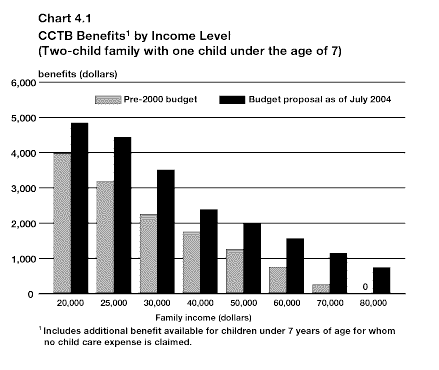
Finance Canada
Budget 2000 - Budget Plan, Chapter 4: Five-Year Tax Reduction Plan - 2
- Franšais - Table of Contents - Previous - Next
-
Substantial Tax Cuts for Middle-Income CanadiansWhile tax burdens will fall for all Canadians, the decline will be substantially larger for middle-income Canadians as:
|
Compared to other Western nations, Canada’s personal income tax rate structure imposes higher taxes at middle-income levels. The increase in the personal income tax rate from low- to middle-income in Canada is the steepest among Group of Seven (G-7) countries.
The current federal tax rate structure was implemented in 1988. There are three federal tax rates applied to different income ranges:
For the first time in 12 years, the Government will lower an income tax rate, specifically the middle tax rate, to 23 per cent from 26 per cent. As a first step, it is proposed that the rate drop 2 points – to 24 per cent – on July 1, 2000 (Table 4.2). The middle tax rate will drop further to 23 per cent within the next five years.
| Because of the 2-point reduction in the middle tax rate, an average
family of four will pay $600 a year less in personal income tax next year. When the
cut is fully in place, it will pay $900 a year less. Almost 9 million taxpayers will benefit from this measure. |
The budget proposes to raise the amount that Canadians can earn tax-free, as well as the amounts that can be earned before the middle and top tax rates begin to apply, even more than would automatically result from indexation.
Increasing tax-free amounts has been the first priority area for general tax relief for the Government since the elimination of the deficit because it delivers proportionally more tax relief to low-income taxpayers. By 2004, tax-free amounts will have increased by $1,544, or 24 per cent, since 1997. This will remain a priority area for further action should more resources become available.
Two surtaxes were introduced in the mid-1980s to reduce the deficit: after some changes in the early 1990s, all taxpayers were subject to the 3-per-cent general surtax, and taxpayers with incomes of over $65,000 were subject to an additional 5-per-cent surtax.
The 3-per-cent surtax was eliminated in the 1999 budget.
Effective July 2000, the budget proposes to eliminate the remaining deficit reduction surtax on Canadians with incomes up to about $85,000 (Table 4.2). As the surtax applies to tax otherwise payable and not on income, its elimination will lower the effective tax on income by 1.45 percentage points (5 per cent of 29 per cent). The surtax will be eliminated for all Canadians over five years, benefiting 2 million Canadians. It is proposed that, effective January 2001, the rate be reduced to 4 per cent of tax payable on income above $85,000.
Registered retirement savings plans (RRSPs) and registered pension plans (RPPs) provide the primary source of retirement income for middle-income Canadians.
Recently, a significant number of Canadians and organizations, including the House of Commons Finance and Senate Banking Committees and the Investment Funds Institute of Canada, have asked the Government to reconsider the current level for the limit on foreign property investments in RPPs and RRSPs. Appropriate limits in this area strike a balance between providing adequate opportunities for Canadians to diversify their retirement savings investments and ensuring that a substantial portion of these tax-assisted savings remains invested in Canada.
As a result, it is proposed that the permissible foreign content of investments in RPPs and RRSPs be raised to 25 per cent for 2000 and to 30 per cent for 2001. These increases will also apply with respect to the Canada Pension Plan.
The 2000 budget proposes a further increase in the Canada Child Tax Benefit (CCTB) to help families with the added expense of raising children. Benefits will rise both because the CCTB will be fully indexed and because of proposed increases beyond indexation. These increases will build up to $2.5 billion annually by the fifth year to bring the CCTB to more than $9 billion annually.
Benefits for low-income families will rise by $1.3 billion. Of the total investment of more than $9 billion annually, about $6 billion will go to low-income families and about $3 billion to modest- and middle-income families.
The goal by the fifth year will be to raise the maximum CCTB benefit to $2,400 for the first child (with corresponding increases for subsequent children). The maximum benefit for the first child will increase in July 2000 to $2,056 from $1,805, reflecting the impact of actions in the 1999 and 2000 budgets. The maximum benefit will increase to $2,265 in July 2001 (Table 4.2).
The budget proposes a number of steps, in addition to indexation of the CCTB, that will also benefit middle-income Canadian families. The base component of the CCTB will rise. The income level at which the base benefit begins to be reduced will go up with increases in the threshold at which the middle tax rate begins to apply (Table 4.2). Finally, the rate at which benefits decline with increases in income will be lowered.
As Chart 4.1 shows, the changes proposed in this budget will substantially increase benefits to middle-income families. For example, a two-child family with an income of $60,000 will see its CCTB benefit more than double from its pre-2000 budget level of $733 to $1,541 by 2004.

| Budget 2000 Publications | Budget 2000 Main Page |